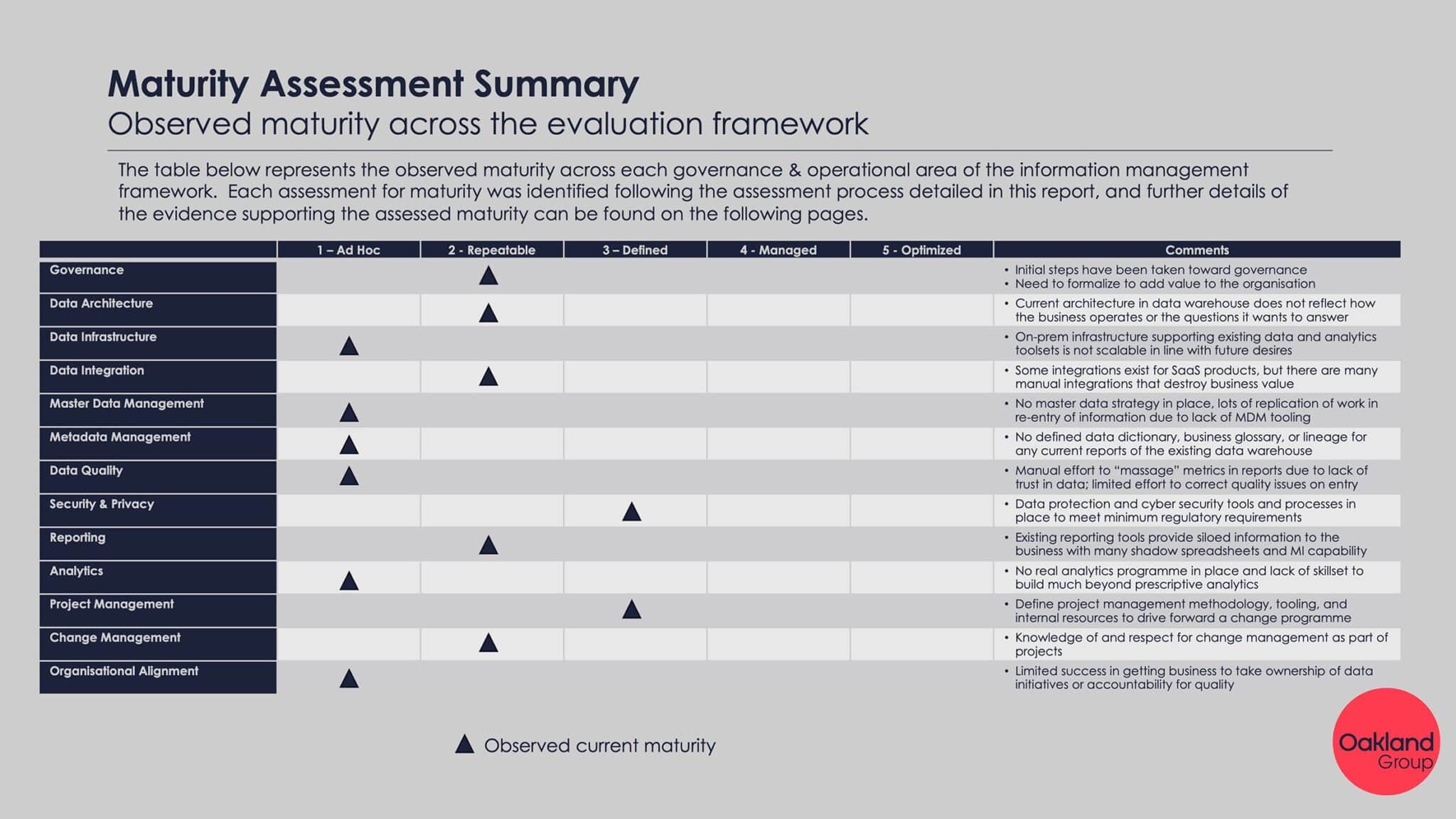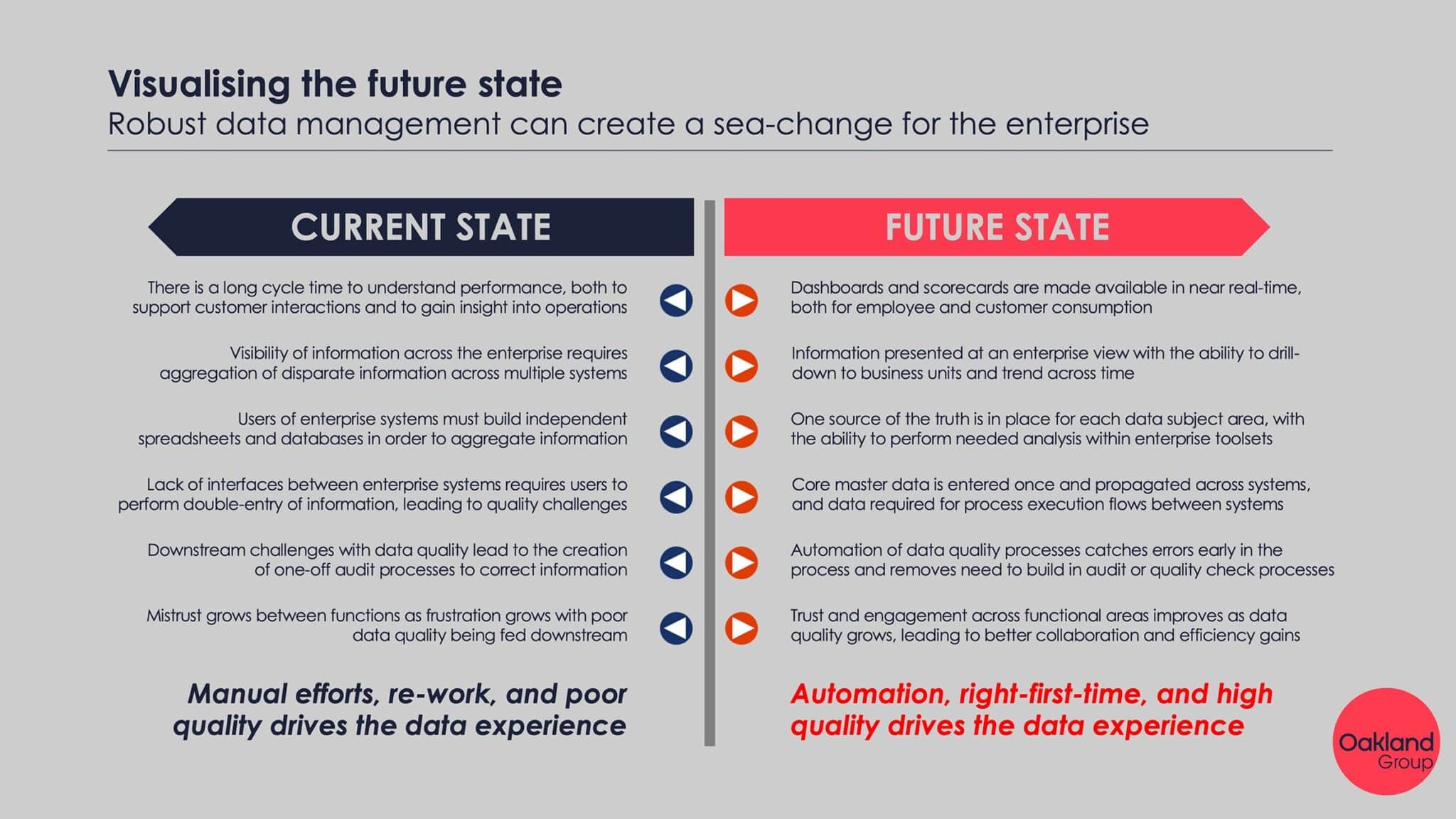“How do we create a data strategy?”
Many organisations face this question as they seek to modernise and drive greater value from their data.
It’s a complex question to address because a data strategy needs to be custom-shaped to your organisation’s specific goals, culture, technology and value proposition. Your organisation is unique, so you can’t cut corners with ‘cookie-cutter’ data strategy templates and blueprints.
But you can apply a structured process to help you and your team discover, design and deploy a customised data strategy that delivers a pathway from your current state to a more desirable future state.
Defining this data strategy creation process is the aim of this the first in a series of articles.
What is driving your data strategy?
Your first step is to ask – “why do we need a data strategy?”.
There are many data strategy use cases, and the number increases each year as organisations seek to drive greater value from their data.
Here are some of the typical cases we come across at Oakland:
“We want to modernise and delight our customers”:
Perhaps you’ve inherited a disjointed data landscape, and you hope to execute a digital transformation program or some aspect of modernisation. Typically this is to improve the customer experience, become more competitive or drive more efficient (lower cost) processes.
“We want data that is fit for purpose”:
Data quality can be a serious thorn in your side, not just as a day-to-day operational frustration but a blocker to faster and more agile digital transformation. Your data shouldn’t just be ‘good enough’, it needs properties that give you an edge, allowing you to adapt faster than your competitors.
“We want faster, more accurate insights”:
Whether it’s better predictive analytics or greater self-sufficiency and autonomy for those who need timely and trusted reports, your analytics initiatives require a data strategy roadmap for success. It’s not enough to invest in a data platform and visualisation tools; you need to start with a strategic data roadmap.
“We want to adapt and ship new products faster”:
When your data is scattered across business siloes, it takes too long to react swiftly to changing market conditions. Scattered data lacks the appropriate controls and governance needed to make quick decisions, further restricting the speed at which your value proposition and services can adapt.
These are just a sample of the data strategy use cases we are asked to help implement – do any of these resonate with your situation?
One of the recurring themes we see is where organisations ignore the need for a data strategy and instead jump headfirst into technical implementations, without heeding the lessons of the past.
The use cases above can often result in technical and business upheaval as new software and technologies get introduced with a localised, short-term mindset instead of a longer-term strategic advantage.
The starting point for your data strategy needs to be a clear understanding of what are we really trying to achieve and how will it create lasting benefits within the broader business whilst creating differentiated value to our customers.
When you combine a robust data strategy with a team committed to designing the data future whilst avoiding the complexity of the past, you create a winning formula.
What are the typical phases of a Data Strategy?
At Oakland, we typically break each data strategy into a series of phases, as shown below:
This article will unpack the ‘Define’ phase in more detail and give you some pointers on how we typically plan the essential activities and produce the final deliverables.

Data Strategy – Discover Phase
“Study the past if you would define the future.”
― Confucius
As the name suggests, this first phase focuses on discovering your existing data capabilities because it’s folly to embark on ambitious data initiatives without understanding the necessary data foundations.
Activity: Review existing data capabilities and build the Current State Assessment (CSA)
What are your strengths and weaknesses concerning data?
This step forms a critical activity during any data strategy. When we execute this step, the output includes a Current State Assessment (CSA) against the Oakland Group Information Management Framework (see below):

For example, in a recent engagement, we discovered the client was mature in their analytics technology and architecture, but their data governance and data quality controls were not mature enough to support a broader push for self-serve analytics across the business.
In another example, the Current State Assessment noted that although the organisation was progressive and forward-thinking, they could often struggle to manage change on strategic, long-range, data initiatives leading to frustration and blockading at the grassroots business user level.
Without a Current State Assessment, you run the risk of accelerating change that your business isn’t equipped to handle, either from a people, process or technological perspective.
Activity: Identify quick wins to increase support and focus
Your data strategy needs a focal point for generating tangible value.
Data improvement and transformation initiatives can invite skepticism (and sometimes outright hostility!), so you need to ‘whet the appetite’ with a morsel of value generation.
At Oakland, we typically introduce the concept of ‘Lighthouse Projects‘ to drive immediate value from your data strategy initiative. These are delivered quickly, typically in 1-3 months, and tackle thorny problems with senior visibility.
Following each Lighthouse Project, we ‘lock in the gains’ by plugging some of the data related gaps identified in the client Current State Assessment and Information Management Framework.
For a detailed example of the Lighthouse Projects concept, please study the following guide:
https://weare.theoaklandgroup.co.uk/data-governance-consulting-services-ad
Activity: Creation of vision and design principles for strategy
Our goal during this step is to examine the current data state, documenting all the past challenges this has created for the organisation, its leadership, staff and customers. Then we contrast with an ideal future state to create a powerful vision for change and transformation.
For example, consider the following current state situation:
Old State: “Departments don’t trust each other because the quality of shared data frustrates business users who have to perform unplanned admin and customer support due to incomplete or inaccurate data”
If we create a vision statement for this situation, it could read something like:
New State Vision Statement: “Trust and engagement across functional areas are assured as data quality levels consistently meet user expectations and internal measures. Our data quality excellence leads to optimal collaboration and efficiency gains.”
Central to building these vision statements is the need to share real stories of frustration, waste and lost opportunities. These stories are gathered during the Current State Assessment exercise and play a vital role in demonstrating the vision and value for your data strategy.
Here is an example of the final output from this activity:

Activity: Build next stage plan
The next step is to plan for the Define phase of your data strategy creation process, where you will begin to validate customer needs based on your vision and Current State Assessment.
A key output of this activity will be a Project Initiation Document (PID) for the subsequent phases that we will cover in the remainder of this series.
Next Steps
In the next article, we explore the Define phase of your data strategy journey.
You’ll learn how to validate internal customer needs, establish important capabilities and begin defining the future state architecture and operating models for data.


